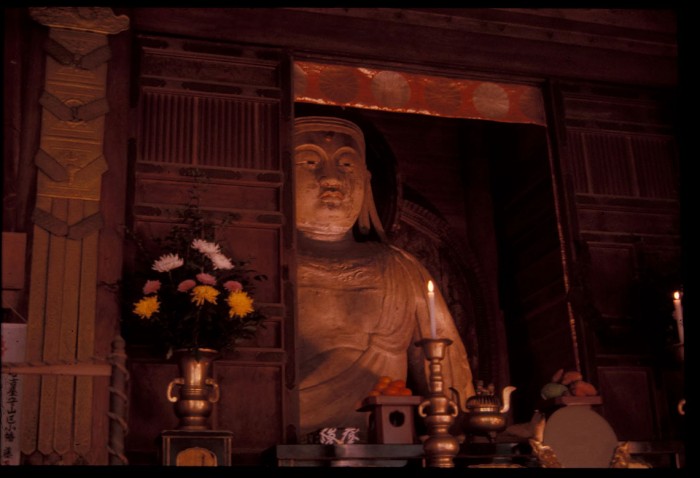
Buddhism entered Japan after the Indian offshoot from Hinduism was transformed in China. Together with Shinto, it is the religion which most Japanese profess to and has been a major religious and cultural influence on Japan.
Buddhism entered Japan in the great wave of Chinese cultural influence in the 6th century. Specifically, Buddhism is said to have arrived in 538. Early Buddhism was appealing in part because of its magical powers. It also had strong appeal among some members of the nobility because of the potential for order it gave to ruling a community, especially in conjunction with the rest of Chinese civilization. Some important court families held it superior to the native religion, Shinto, and when they were able to win the political battles for supremacy, Buddhism was accorded high status. At the same time, however, Buddhism made itself more acceptable and less controversial by identifying its concepts and Buddha with Shinto gods, beginning a process of close association with Shinto. By the 8th century, Buddhism became the state religion and was spread throughout the empire. It was primarily a religion of the elite, with detailed knowledge made available only to a select few. Only when new sects, Tendai and Shingon Buddhism, were imported from China, did the religion spread among the common people in the 9th and 10th centuries. In the 12th century, Zen Buddhism and Pure Land Buddhism were also brought to Japan and Nichiren Buddhism developed domestically.
Tendai and Shingon Buddhism maintain complex and erudite philosophies together with mystical gestures and magical rituals which have been consistently popular. Pure Land Buddhism puts an emphasis on salvation through the aid of individuals who have achieved enlightenment (boddhisatvas), but who delay entry into paradise in order to help others; for example, Jizo whose statues commonly appear along highways, is a boddhisatva who is a special help to travelers, to children, and to those suffering in hell. Nichiren Buddhism, named after a Japanese priest, is an internal development which concentrates on a single scripture, the Lotus Sutra. It is famous for intolerance of other sects and seeks actively to convert people. From it descend sects such as the Soka Gakkai which have extended vigorous missionary movement even outside Japan. Zen Buddhism is very contemplative and was favored by the samurai class, especially during the Edo period. It was seen as being in tune with the military necessities facing the samurai as well as a source of high culture; Zen had a close relationship to tea ceremony, flower arranging, and gardening which became favorite art and contemplative forms of the samurai.

boddhisatvas
Japanese Buddhism has characteristics somewhat different from other forms of the religion. It has maintained a high level of social involvement compared to Chinese Buddhism. Each sect also tends to exclude members of other Buddhist sects (although not necessarily members of Shinto sects). It also puts a very high value on the master to disciple connection; temples and secret teachings have been passed down in this manner. Much of the Japanese form of Buddhism is not rationalistic; no great doctrinal systems have emerged from Japan to effect the rest of the Buddhist world. There is a great tendency to accept what is found and not change it; thus, Buddhism accommodated itself to Shinto without great trouble even though the two religions are dissimilar and have entirely different roots.
The Buddhist accommodation with Shinto partly explains why the Chinese religion was quickly accepted in Japan. Not only was it impressive as an intellectual construct, but in Japan it drew close parallels between Buddhism and Shinto. The identification of the two religions went so far that the two were virtually indistinguishable for centuries. The same individual was often a priest in both religions and Buddhist temples functioned as Shinto shrines at the same time. “Magical” Shinto deities would protect the Buddhist temples. Only in the Edo period did the two begin to draw apart and in the Meiji period the government insisted on strict separation between the two.
Today, there are thirteen major sects with about 80% of the population professing belief: 80,000 temples and 150,000 priests. At the same time, its ideas, beyond a very simplistic level, are not popularly comprehended and it is hardly a force among intellectual leaders. Still, Japanese Buddhism is well known outside of Japan, particularly Zen, and new sects have been very active within. Although Buddhism may not be an immense influence today, it has had a major effect on Japanese art and its preservation. Zen Buddhism can almost been seen as an art form, rather than a religion, while all other forms of Buddhism have been major benefactors of all kinds of art and the temples have preserved and protected vast amounts of artistic output.
A World Wide Web site with extensive material about Japanese Buddhism from early through to medieval times has been produced at the University of Aizu. Although the University hopes to expand their site which is devoted to Japanese history from the prespective of former Aizu province (now Fukushima Prefecture), only the Buddhism segment is presently completed.

